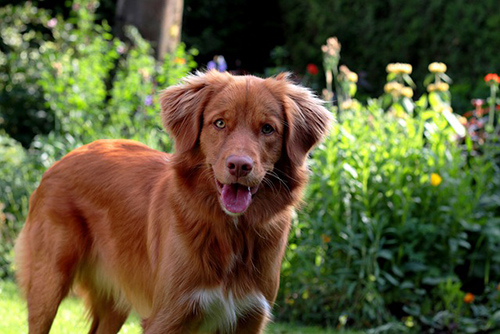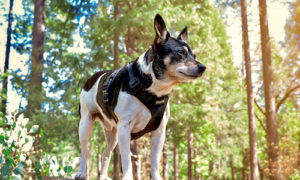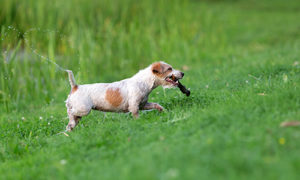
The Nova Scotia Duck Tolling Retriever can trace its lineage back to various retrievers, setters, collies, and spaniels brought to Nova Scotia by early settlers. The dog, used as a retriever and toller, was developed in the 19th century and was initially called the Little River Duck Dog. The dogs worked as bait to attract waterbirds. Their spirited conduct and flickering tails would stimulate the interest of ducks and tempt them to come near the shoreline, gradually enticing them into range. The dog was recognized in Canada, its homeland, in 1945 and was introduced to the United States in the 1960s.

Breed Standard
The Nova Scotia Duck Tolling Retriever happens to be the smallest retriever breed. This medium-sized and compact dog is powerful and athletic. It has a medium-length neck, a level back, a deep chest, and oval-shaped, webbed feet. The dog’s tail is broad and long at the base, well feathered, and held high in a curve when alert.
The Toller’s skull is broad, wedge-shaped, and slightly rounded with a tapered muzzle. The eyes are almond-shaped and wide-set. The ears, which are covered with feathering and frame the face, are triangular with rounded tips, set high, and long enough to reach the inside corner of the eye. The breed has a friendly, alert, and intelligent expression.
Breed Facts
| Energy level | Watchdog ability | ||
| Exercise requirements | Protection ability | ||
| Playfulness | Grooming requirements | ||
| Affection level | Cold tolerance | ||
| Friendliness toward dogs | Heat tolerance | ||
| Friendliness toward other pets | Friendliness toward strangers | ||
| Ease of training |

Activity level: High. Alongside hunting, these dogs love agility, obedience, and tracking. Nova Scotia Duck Tolling Retriever’s need plenty of exercises mainly involving retrieving and playing. They do well with mental challenges, including agility and obedience. These dogs love water and are devoted family companions that love to interact with their humans.
Grooming: These dogs require brushing two times a week, which keeps the coat healthy and lustrous. Also, check the ears regularly for parasites and foreign objects.
Coat: This breed possesses a water-repellent double coat and a soft, dense undercoat. The desired medium-length coat may have a slight wave. The coat on the muzzle is shorter, and there is feathering on the tail and ears.

Color: Any shade of red, possibly with white markings.
Group: Sporting
Year recognized by the AKC: 2003
- Popularity: Somewhat uncommon
- Family Group: Gundog, Retriever
- Country of Origin: Nova Scotia
- Date developed: 1800s
- Original purpose: Duck tolling and retrieving
- Today’s purpose: Duck tolling and retrieving
- Other names: Little River Duck Dog
Nova Scotia Duck Tolling Retriever Temperament

This dog is an alert, determined hunter with a strong desire to please and work. However, it can be reserved with strangers. Most breeders place great emphasis on hunting abilities in this breed. These dogs are meant to play and retrieve tirelessly because they are very playful and energetic. There is no throwing a ball or frisbee just once for a Toller.
These dogs do everything with enthusiasm, whether they’re just walking around the block, hunting, obedience, or agility training. Tollers are vigilant dogs but not too hyperactive, making them highly adaptable to many circumstances. They are gentle and affectionate; however, young dogs can be a little too boisterous at times. The breed is excellent with children, pets, and other dogs. They learn quickly and are highly willing to please, but they can get bored easily and tend to be a little stubborn. Tollers can get too excited, making them very vocal and known for a shrill known as the “Toller scream.”
Health

- Main concerns: none
- Minor problems: CHD, PRA
- Rarely seen: none
- Recommended tests: hip, eye, DNA for PRA
- Life span: 11 to 13 years
- Weight: male – 45 to 52 pounds; female – 35 to 42 pounds
- Height: male – 18 to 21 inches; female – 17 to 20 inches
Breeder and Buyer’s Advice
Potential Nova Scotia Duck Tolling Retriever owners need to begin socializing puppies early and learn to channel their puppy’s energy into suitable activities. Please consider enrolling them in professional puppy training classes.
- Parent club: Nova Scotia Duck Tolling Retriever Club (https://www.nsdtrc-usa.org/); founded in 1984
- Rescue: The parent club’s Toller rescue program can be found on the website.




